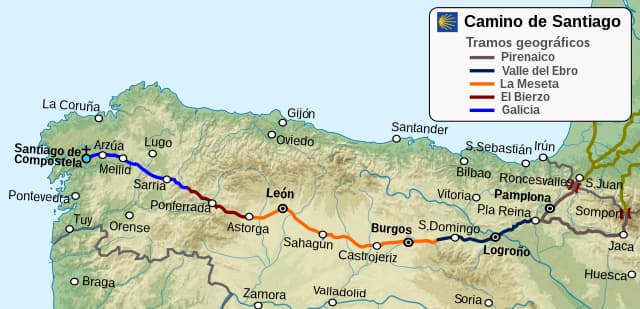From the bustling markets of Rome to the distant shores of China, ancient civilizations were connected by a vast network of trade routes that crisscrossed continents, spanned oceans, and shaped the course of history. These ancient routes served as lifelines of commerce, conduits of culture, and corridors of conquest, facilitating the exchange of goods, ideas, and technologies across vast distances. In this article, we embark on a journey through time and space to explore ten of the most important ancient routes that left an indelible mark on the world.
Join us on a fascinating journey through history as we uncover the stories of these ancient routes and their enduring legacy on the world stage. From the rugged peaks of the Andes to the windswept plains of the Eurasian steppe, each route offers a glimpse into the rich tapestry of human experience and the interconnectedness of our global heritage.
1. Silk Road
- Length: 6,000 kilometers (3,700 miles)
- Route: several interconnected land and maritime routes, linking East Asia with the Mediterranean world
- Purpose: crucial conduit for the exchange of goods, ideas, cultures, and technologies between the East and the West
- Construction:ancient times
- Significance:immense historical, cultural, and economic significance

The Silk Road was a vast network of trade routes spanning over 6,000 kilometers, connecting East Asia with the Mediterranean world. It facilitated the exchange of goods, ideas, cultures, and technologies between regions. Originating in China’s capital, Chang’an, the route traversed Central Asia, the Middle East, and into Europe. Alongside silk, it enabled trade in spices, precious metals, and more, shaping economies and cultures. Emerging over centuries, its peak trade occurred during the Han and Tang Dynasties. The Silk Road fostered economic prosperity, cultural exchange, and the spread of religions and philosophies, leaving a lasting impact on global history and shaping the course of civilizations. Today, it remains a symbol of interconnectedness and cultural exchange.
2. Via Appia (Appian Way)
- Length:560 kilometers (350 miles)
- Route: from Rome to the South of Italy
- Purpose: initially built as a military road later became a vital trade route
- Construction: constructed in 312 BCE
- Significance: holds immense historical and cultural significance as one of the earliest and most important Roman roads

Image by Erik Torner/
The Via Appia, or Appian Way, was an ancient Roman road stretching 560 kilometers from Rome to Brindisi in southern Italy. Constructed in 312 BCE by Appius Claudius Caecus, it served military, commercial, and cultural purposes, facilitating troop movements, trade, and the spread of Roman influence. Its construction marked a significant achievement in Roman engineering and played a key role in the expansion of Roman power. Today, the Via Appia stands as a testament to Roman ingenuity and remains a popular tourist attraction.
3. Kumano Kodo (Japan)
- Length: 170 kilometers (106 miles)
- Route: Lead through the mountainous Kii Peninsula in Wakayama Prefecture, Japan
- Purpose: served as pilgrimage routes for worshippers
- Construction: during the Heian period (794-1185), with some paths dating back even earlier
- Significance: holds great significance as one of Japan’s most important pilgrimage routes and UNESCO World Heritage Sites

The Kumano Kodo is a network of ancient pilgrimage trails in Japan, leading to the sacred sites of Kumano Sanzan, which include Kumano Hongu Taisha, Kumano Nachi Taisha, and Kumano Hayatama Taisha. These trails have been used for over 1,000 years by pilgrims seeking spiritual enlightenment and connection with nature. The Kumano Kodo is renowned for its beautiful natural landscapes, serene atmosphere, and rich cultural heritage. It represents a unique blend of Shinto and Buddhist beliefs, cultural practices, and natural landscapes. The trails not only provided access to sacred sites but also facilitated cultural exchange, trade, and regional development throughout Japan’s history. Today, the Kumano Kodo continues to attract pilgrims, hikers, and tourists from around the world who seek to experience its spiritual essence and natural beauty.
4. Incense Route (Asia)
- Length: 3,000 kilometers (1,900 miles)
- Route: through the desert regions of the Arabian Peninsula to the Mediterranean ports
- Purpose: vital trade network for the transportation of frankincense, myrrh, and other exotic spices
- Construction: around the 3rd century BCE
- Significance: crucial role in connecting the ancient civilizations of the Arabian Peninsula with the Mediterranean world
This network of ancient trade routes connected the Mediterranean world with the Arabian Peninsula, facilitating the trade of valuable spices, incense, and other luxury goods. It played a significant role in the economies of ancient civilizations such as Egypt, Rome, and Persia. The Incense Route was a sprawling trade network spanning 3,000 kilometers across the Arabian Peninsula, linking the southern Arabian kingdoms with the Mediterranean ports. It primarily facilitated the trade of valuable commodities like frankincense and myrrh, essential for religious rituals and luxury goods. Flourishing from around the 3rd century BCE to the 3rd century CE, the route promoted economic prosperity and cultural exchange between ancient civilizations. Its legacy is evident in the archaeological sites and remnants scattered along its path, serving as a testament to its historical significance and cultural impact.
5. Grand Trunk Road (Asia)
- Length: 2,500 kilometers (1,550 miles)
- Route: stretches from Kabul in Afghanistan, through the Khyber Pass in Pakistan, across the northern plains of India, to Kolkata
- Purpose: trade route
- Construction: during the 16th century
- Significance: one of the oldest and longest road networks in the world

The Grand Trunk Road connects the eastern and western regions of the Indian subcontinent. It stretches from Kabul in Afghanistan to Kolkata in West Bengal, India. Originally constructed during the Mauryan Empire in the 3rd century BCE, it served as a vital trade route linking ancient civilizations and facilitating cultural exchange between the Indian subcontinent and Central Asia. Over the centuries, it underwent expansions and renovations by rulers such as Emperor Chandragupta Maurya and Sher Shah Suri, adapting to changing trade needs. The Grand Trunk Road played a crucial role in the movement of goods, people, and ideas, contributing to the economic and cultural development of the regions it traversed. It holds immense historical and cultural significance, acting as a conduit for the spread of religions, languages, arts, and architecture. While modern transportation has diminished its importance, parts of the Grand Trunk Road remain integral to the Indian subcontinent’s transportation network.
6. Royal Road of Persia
- Length: Over 1,500 miles (2,400 kilometers)
- Route: Susa (Persia) to Sardis (Anatolia)
- Purpose: Communication, trade, and military movement
- Construction: Gravel surface, milestones
- Significance: Facilitated efficient administration and boosted trade within the Persian Empire

The Royal Road of Persia was an ancient highway that stretched for over 1,500 miles (2,400 kilometers) from Susa, the capital of the Achaemenid Empire, to Sardis in Anatolia (modern-day Turkey). Built by the Persian Empire King Darius I the Great in the 5th century BC, the road served as a vital artery for communication, trade, and military movement throughout the vast empire.
The Royal Road was an impressive feat of engineering, traversing diverse terrains including mountains, deserts, and plains. It was constructed with a gravel surface and lined with milestones, making it one of the most advanced roads of its time.
7. Inca Road System (South America)
- Length: over 25,000 miles (40,000 kilometers)
- Width: The roads varied in width from 1 to 4 meters (3 to 13 feet)
- Purpose: Often built with drainage systems to prevent erosion
- The roads were marked with milestones and tambos (rest stops)
- Route: spanned a vast territory across western South America. It covered parts of modern-day Ecuador, Peru, Bolivia, Chile, and Argentina

The Inca Road System, also known as the Qhapaq Ñan, was an extensive network of roads and trails built by the Inca Empire in South America around 1400 AD. It is considered one of the most impressive engineering feats of the pre-Columbian era, stretching over 40,000 kilometers (25,000 miles) and connecting all parts of the empire.
The roads were built without the use of the wheel, relying on human and llama caravans for transportation. They were constructed using a variety of materials, including stone, earth, and wood, and were often built to withstand the harsh Andean climate.
8. Karakoram Highway (Central Asia)
- Length: 1,300 kilometers (800 miles).
- Route: from Hasan Abdal in Pakistan to Kashgar, China
- Purpose: link between Pakistan and China
- Construction: 1960s
- Significance: crucial artery for trade, tourism, and regional cooperation between Pakistan and China

Known as the “Eighth Wonder of the World,” the Karakoram Highway is one of the highest paved international roads, connecting Pakistan and China through the Karakoram mountain range. It serves as a vital trade route between South Asia and Central Asia. These ancient routes played pivotal roles in shaping the economic, cultural, and political landscapes of their respective regions, fostering exchanges that contributed to the development of human civilization. Its construction through challenging terrain, including high mountain passes, underscores its significance as a strategic corridor. The Karakoram Highway is not only a symbol of regional connectivity but also a major tourist attraction, drawing visitors to its stunning landscapes and rich cultural heritage.
9. Amber Road (Europe)
- Length: 1,600 kilometers (1,000 miles)
- Route: from the Baltic Sea coast through various regions of Central Europe, and eventually the Mediterranean Sea.
- Purpose: facilitate the trade of amber
- Construction: prehistoric times
- Significance: crucial role in connecting different regions of Europe
The Amber Road was an ancient trade route spanning approximately 1,600 kilometers across Europe, connecting the amber-rich Baltic Sea region to the Mediterranean. It facilitated the trade of amber and other goods, fostering economic and cultural exchange among ancient civilizations. While its origins date back to prehistoric times, the route gained prominence during the Bronze Age and continued to be utilized throughout antiquity and the medieval period. The Amber Road played a crucial role in shaping European trade networks, promoting cultural interactions, and contributing to the development of early civilizations. Today, it remains a symbol of ancient connectivity and heritage, with archaeological sites and cultural projects preserving its legacy.
10. Trans-Saharan Trade Routes (Africa)
- Length: network of trade routes that stretched across the vast expanse of the Sahara Desert
- Route: from North Africa, particularly cities such as Cairo, Tunis, and Tripoli, southward across the Sahara Desert to the Sahel region, including Timbuktu, Gao, and Djenne, and West Africa
- Purpose: facilitate the exchange of goods, primarily gold, salt, ivory, and slaves, between the regions of North Africa and West Africa.
- Construction: ancient origins
- Significance: crucial role in the economic, cultural, and political development of the regions they connected

Image by Fred Dunn
The Trans-Saharan Trade Routes comprised an extensive network spanning the Sahara Desert, facilitating trade between North Africa and West Africa. Stretching from cities like Cairo to trading hubs in the Sahel and West Africa, they enabled the exchange of goods like gold, salt, ivory, and slaves. Flourishing from ancient times to the medieval period, these routes shaped the economies, cultures, and political landscapes of the regions they connected. They contributed to the rise of powerful empires, facilitated the spread of Islam, and promoted cultural exchange between diverse peoples.
11. Tea Horse Road (China)
- Length: 6,000 kilometers (3,700 miles)
- Route: from tea-growing areas of Yunnan province in southwestern China, to the Himalayas and beyond
- Purpose: facilitate the trade of tea
- Construction: 7th-10th centuries
- Significance: immense economic, cultural, and historical significance

The Tea Horse Road, spanning approximately 6,000 kilometers, linked tea-producing regions in southwestern China with Tibet and beyond. Originating in Yunnan, it facilitated the trade of tea for Tibetan horses, as well as other goods like salt and medicinal herbs. Dating back over a millennium, it reached its zenith during the Ming and Qing Dynasties, fostering economic prosperity and cultural exchange between China and Tibet. Today, it stands as a significant cultural heritage site, symbolizing centuries of trade and cultural interaction.
12. King’s Highway (Jordan)
- Length: 280 kilometers (175 miles)
- Route: from the northern city of Um Qais, near the Jordanian border with Syria, to the southern city of Aqaba
- Purpose: crucial trade and pilgrimage route
- Construction: dating back thousands of years to antiquity
- Significance: immense historical, cultural, and archaeological significance

The King’s Highway in Jordan spans 280 kilometers from Um Qais to Aqaba, serving historically as a trade and pilgrimage route. Dating back thousands of years, it connected ancient kingdoms and facilitated the exchange of goods and ideas. Passing through significant sites like Madaba and Petra, it remains a vital part of Jordan’s cultural and historical heritage, attracting tourists to explore its rich history and scenic landscapes. The King’s Highway holds immense historical, cultural, and archaeological significance as one of the oldest and most important routes in the Middle East. It played a vital role in the economic, political, and religious life of the region, facilitating trade, pilgrimage, and cultural exchange between ancient civilizations. Today, the highway remains a popular tourist route, offering visitors the opportunity to explore Jordan’s rich history and heritage, including its stunning archaeological sites, scenic landscapes, and vibrant communities along the route.
13. Hadrian’s Wall Path (UK)
- Length: 135 kilometers (84 miles)
- Route: from near Newcastle upon Tyne, and extends westward to Bowness-on-Solway in Cumbria
- Purpose: defensive fortification marking the northern boundary of the Roman Empire in Britain
- Construction: built by the Roman Emperor Hadrian in the 2nd century AD
- Significance: holds significant historical and cultural importance as a UNESCO World Heritage Site
Hadrian’s Wall Path stretches 135 kilometers through northern England, tracing the route of Hadrian’s Wall. Originally built by Emperor Hadrian in the 2nd century AD as a defensive fortification, it now serves as a walking trail, offering visitors insights into Roman Britain’s history. Constructed primarily of stone and turf, the wall spans from Wallsend to Bowness-on-Solway. A UNESCO World Heritage Site, the path attracts tourists and history enthusiasts keen to explore its archaeological remains and scenic landscapes.
14. Camino de Santiago (Spain)
- Length: 800 kilometers (500 miles)
- Route: the most popular is the Camino Francés, from Saint-Jean-Pied-de-Port, France to Santiago de Compostela, Spain
- Purpose: Christian pilgrimage
- Construction: ancient origins
- Significance: holds immense cultural, historical, and spiritual significance
The Camino de Santiago, spanning over 800 kilometers through Spain, is a renowned pilgrimage route leading to the Cathedral of Santiago de Compostela. Popular routes include the Camino Francés and Camino Portugués, among others. Originating in the Middle Ages, the Camino holds cultural, historical, and spiritual significance, attracting pilgrims and tourists worldwide. It offers opportunities for personal reflection, physical challenge, and cultural exchange, making it a unique and cherished journey for people of all backgrounds.













